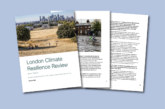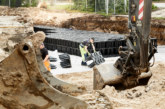Kevin Kiernan, National Sales Manager for Bowater by Birtley, looks at why local authorities and housing associations should look at environmental factors as well as advances in technology and materials when choosing a suitable residential entrance solution.
Flooding is the greatest natural threat facing the UK. Before the autumn of 2018 arrived, we experienced the chaos storms can bring. With Ali and Bronagh causing damage and flash flooding in many parts of the UK, homeowners, local authorities and housing associations were left to deal with the aftermath and inevitable clean up.
According to the Government’s own figures, nearly two million properties in floodplains along rivers, estuaries and coasts in the UK are potentially at risk of river or coastal flooding. In addition, a further 80,000 properties are at risk in towns and cities from flooding caused by heavy downpours that overwhelm urban drains. The Financial Times also reported that figures in 2016 showed that Great Britain was building nearly 10,000 new houses per year on floodplains.
In recent years we have all seen countless images of homeowners with sandbags piled high, battling to protect their property from the damage caused by rising floodwater. Often, like the occurrence in Cumbria, only for it to strike again a few years later costing insurers £272m in claims.
Protection and prevention
Flood doors are a permanent ‘fit and forget’ fixture that remains in place should the waters start to rise. They are usually indistinguishable from a regular composite door, yet the structure and seals are designed to significantly reduce the amount of water entering a property. As with all products, testing is the key to ensuring you have a validated flood defence solution.
The Bowater by Birtley Floodshield system is one of only a handful of composite doors tested to PAS 1188, the UK standard for flood protection products. To achieve this, the door was placed in a water tank and subjected to static water; waves and currents to ensure the system delivered a significantly less leakage rate over a period of time.
This range of double rebate composite doors were introduced to the market in 2017, in response to the growing problem of flash flooding and climate change predictions. Bowater invested heavily in the design and testing of this system to ensure there was an easy to install product available on the market to offer reassurance to local authorities and housing associations.
Fire Protection, Specification and the Golden Thread
Fire doors are the first line of defence when a fire breaks out, however correct specification, installation, maintenance and management can be the difference between life and death. Despite this, Fire Door Safety Week reported that over three million new fire doors are bought and installed every year in the UK, yet they are often the first thing to be downgraded on a specification.

Testing times
There are standards doors should comply with depending on the application, for example emergency escape and panic escapes. BS EN 1634 is the fire resistant test for doors and shutter assemblies, so when specifying a fire door, it needs to meet this standard. This ensures that they have been subjected to a rigorous test procedure at a certified test house. They should also have been tested to EN 1634-3:2004, the smoke control test for door and shutter assemblies.
Seamless, smart specification
BIM is a term that has become universal in the construction industry over the past 10 years and since the implementation of the Government Mandate, it has moved forward at an unprecedented rate. Utilising BIM, they will help deliver accurate and seamless specification and contribute to the golden thread and digital record of information for each building.
Installation essentials
The correct installation of fire doors is fundamental when it comes to their performance, it’s as important as ensuring the specified product meets all the required standards. The slightest gap or crack between the door and frame could enable smoke flames to escape and jeopardise the performance of the door.
It is vitally important that a competent and skilled fitter is given the task of installing a fire door. It is also essential that they follow the manufacturers installation instructions, as this is the method of fitting used in the initial EN BS EN 1634 tests.
Bowater by Birtley has introduced a new fully BIM compliant FireShield FD30S fire door after successfully securing BS EN 1634 certification and PAS 24.
The door is manufactured using a sustainable agrifiber core, a material recognised as a green product that can contribute to Leadership in Energy and Environmental Design (LEED) credits. A solid timber frame and durable GRP facing completes the construction of the door, making it one of only a handful on the market to offer a FD30S certified door to this standard.
Following rigorous, independent testing to European Standards at a specialist test house in Germany, the range has been proven to maintain its integrity beyond the required minimum 30 minutes, preventing the passage of flames and hot gases.

Smooth Operators with a stylish finish
Steel doors have long been a favourite amongst local authorities and housing associations due to a perception that they were a sturdier, secure and stronger alternative to other door materials.
Although steel is a strong material, studies have shown they aren’t as weather resistant as their composite alternatives. Steel doors were also susceptible to dents and scratches, which, if left untreated eventually led to rusting and a large maintenance bill (and headache) for local authorities.
Composite doors are often overlooked as an alternative as many are supplied with a woodgrain finish, giving the perception of a timber door. However they utilise the latest technology, materials and require little maintenance in comparison to steel and timber doors.
Material things
The majority of composite doors come with a Glass Reinforced Polyester (GRP) ‘skin’, a material that offers a high level of corrosion resistance in the harshest environments; it’s often used in challenging marine applications. Aesthetically, it’s versatile as it can be molded into a variety of finishes including woodgrain and coveted smooth textures.
Composite doors, as the name suggests are made from multiple materials including wood and insulation foam that each work in synergy to boost the doors performance, from energy and acoustic efficiency to durability.
Bowater by Birtley recently introduced a smooth GRP skin alongside its woodgrain offering to replicate the finish of a steel door to offer an alternative reliable and low maintenance entrance solution that will stand the test of time. The doors are available with Secured by Design accreditation and achieve a U-value as low as 0.8 W/m2K.









